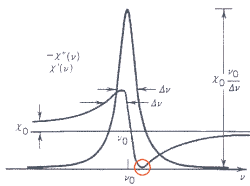
In AWT foam structure is an emergent result of incoming light dispersion by field of CMB fluctuations (i.e. gravitational waves) and as such it depends on observational perspective - the more, the more is distant from local human scale. From AWT perspective Universe is quite random environment, and extremely low portion of energy can spread through it in pure transversal way, thus raising the existence of causal observational perspective of human creatures. This perspective is sampling the causal portion of Universe in such way, it ignores dispersion of radiation nearly completely.

Under normal circumstances, the outer surfaces of rain droplets with positive curvature are more pronounced, so that normal dispersion prevails and one rainbow is formed. But at the case of heavy rain the anomalous dispersion on inner surfaces of rain droplets becomes dominant and the secondary rainbow is formed.
From AWT perspective the observation of primary rainbow corresponds the observation of large massive body, white hole surface in particular. The secondary bow corresponds the inner surface of foamy streaks of dark matter, consisting mainly of antimatter particles, heavily expanded during inflation. This perspective renders dark matter streaks as a symmetric phenomena of black hole surfaces. The Alexander band with no apparent dispersion itself corresponds the observation of space-time brane (a "transparent window"), forming cosmic space from insintric perspective. This model explains, the dispersion is restricted to narrow band, forming the physical surfaces of massive bodies, so that vacuum appears basically dispersion-less, but it appears dark (Olbers' paradox) at the price.
The absorption and refraction coefficients are related by Kronig-Kramers equations, named in honor of Ralph Kronig and Hendrik Anthony Kramer. By these equations dispersion is volume phenomena of longitudinal waves and refraction the product of surface gradients, where transversal waves are involved. These functions are dependent to dimensional scale (i.e. wavelength) and phase shifted by half-period in causal space due the Lorentz/Wick rotation. Because hypersphere surface is first derivation of its volume, it basically means, dispersion curve is first derivation of absorption spectrum.
This simple dependence explains the symmetry breaking observed inside of our gradient driven reality, because the minimal speed (the position denoted by red circle on the above graph) of transversal energy spreading in dispersive spreading isn't exactly symmetric to position of absorption maximum. The requirement of minimal speed of transversal wave spreading follows from nearly infinite size of observable Universe. This effectively mean, symmetry violation is a consequence of the large space-time observed via density fluctuations of inhomogeneous environment and we can observe these fundamental connections even during rainy weather.
This simple dependence explains the symmetry breaking observed inside of our gradient driven reality, because the minimal speed (the position denoted by red circle on the above graph) of transversal energy spreading in dispersive spreading isn't exactly symmetric to position of absorption maximum. The requirement of minimal speed of transversal wave spreading follows from nearly infinite size of observable Universe. This effectively mean, symmetry violation is a consequence of the large space-time observed via density fluctuations of inhomogeneous environment and we can observe these fundamental connections even during rainy weather.





3 comments:
A Systemized View of Superluminal Wave Propagation (PDF)
In recent years the vacuum is modeled with metamaterials, which is essentially the relevant approach, because in dense aether model the space-time foam has a properties of metamaterial too. Inside the metamaterials the light is scattered in similar way, like the light around black holes, for example: we can recognize the photon sphere and the event horizon, which swallows all energy with no mercy. But the other consequences of metamaterial model of vacuum aren't so studied, as they violate the mainstream theories. One of these consequences is the existence of time-reversed waves. These waves are illustrated here. The central part of animation is representing the actual metamaterial in which the ripples are spreading in the opposite direction from their source.
Therefore if we admit the metamaterial model of transverse light wave scattering (A) inside of vacuum, we should admit even (B), which is very weird possibility, that the very subtle and rare events may be affected even with our future. And these events are mediated with scalar waves, which are essentially the evanescent waves of the vacuum density fluctuations. With respect to light these events have causality reversed and because we cannot see into future in general, we are considering them a random noise. But if we would monitor the subtle changes in CMBR noise, we could deduce some distant/future events, which weren't still observed with light waves. Note than in dense aether model the CMBR noise is manifestation of gravitational waves, which are superluminal and essentially random in AWT. But their subtle portion may be observable like the time reversed waves traveling TOWARD their source.
One of the reasons, why I'm interested about this model is, they could be detected with neurons inside of our brain and they could represent the tangible physical basis for various esoteric psychic phenomena like the telepathy and divination.
https://i.imgur.com/dcsXTkh.jpeg
Post a Comment